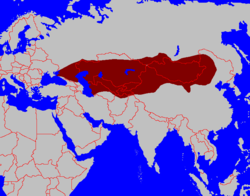Second Turkic Khaganate
| Turkic Khaganate | ||||||||||||||||||
| (Kök) Türk xanlïqï Göktürk Kağanlığı |
||||||||||||||||||
| Khaganate | ||||||||||||||||||
|
||||||||||||||||||
|
The Göktürk Khaganate at its greatest extent, in 576.
|
||||||||||||||||||
| Capital | Ötüken | |||||||||||||||||
| Languages | Turkic | |||||||||||||||||
| Religion | Tengrism | |||||||||||||||||
| Political structure | Khaganate | |||||||||||||||||
| Khagan | ||||||||||||||||||
| • | 551–552 | Bumin Khagan | ||||||||||||||||
| • | 553–572 | Muqan Qaghan | ||||||||||||||||
| • | 682–691 | Ilterish Qaghan | ||||||||||||||||
| • | 742–744 | Ozmış Khagan | ||||||||||||||||
| Legislature | Kurultai (Qurultay) | |||||||||||||||||
| Historical era | Post-classical | |||||||||||||||||
| • | Bumin Qaghan revolts against Rouran Khaganate | 542 | ||||||||||||||||
| • | Established | 552 | ||||||||||||||||
| • | Göktürk civil war | c. 582 | ||||||||||||||||
| • | Defeat of Eastern Turkic Khaganate | 630 | ||||||||||||||||
| • | Defeat of Western Turkic Khaganate | 659 | ||||||||||||||||
| • | Ilterish Qaghan establishes Second Turkic Khaganate | 682 | ||||||||||||||||
| • | Uyghurs defeat Özmiş Khagan | 744 | ||||||||||||||||
| Area | ||||||||||||||||||
| • | 557 | 6,000,000 km² (2,316,613 sq mi) | ||||||||||||||||
|
||||||||||||||||||
in Anatolia
Artuqid dynasty
Saltuqid dynasty
in Azerbaijan
Ahmadili dynasty
Ildenizid dynasty
in Egypt
Tulunid dynasty
Ikhshidid dynasty
in Fars
Salghurid dynasty
in The Levant
Burid dynasty
Zengid dynasty
in Yemen
Rasulid dynasty
The Turkic Khaganate (552–744; Old Turkic: ![]()
![]()
![]()
![]()
![]()
![]()
![]() , Chinese: 突厥汗国; pinyin: Tūjué hánguó), Skyturks or Göktürk Khaganate was a khaganate established by the Ashina clan of the Göktürks in medieval Inner Asia. Under the leadership of Bumin Qaghan (d. 552) and his sons, the Ashina succeeded the Rouran Khaganate as the main power in the Mongolian Plateau and established a stronger empire, which rapidly expanded to rule huge territories in Central Asia. This khaganate interacted extensively with various dynasties based in North China, and for significant periods exercised considerable control over the lucrative Silk Road trade.
, Chinese: 突厥汗国; pinyin: Tūjué hánguó), Skyturks or Göktürk Khaganate was a khaganate established by the Ashina clan of the Göktürks in medieval Inner Asia. Under the leadership of Bumin Qaghan (d. 552) and his sons, the Ashina succeeded the Rouran Khaganate as the main power in the Mongolian Plateau and established a stronger empire, which rapidly expanded to rule huge territories in Central Asia. This khaganate interacted extensively with various dynasties based in North China, and for significant periods exercised considerable control over the lucrative Silk Road trade.
...
Wikipedia


